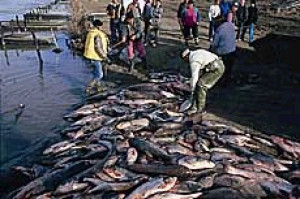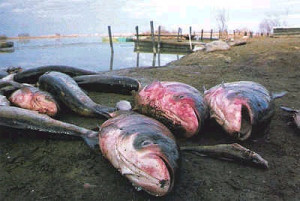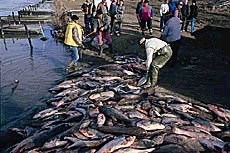In a gold ore retreatment facility opened in May 1999, a settling basin for tailings storage collapsed after a 25-m long crack formed. A total of 287,500 m³ of effluent laced with cyanide (400 mg/l, 115 tonnes total) and heavy metals (Cu, Zn) spilled, contaminating a 14-hectare sector and polluting the SASAR River. A 40-km “cyanide wave” swept through the LAPUS, SZAMOS and TISZA Rivers before finally reaching the DANUBE. The cyanide concentration rose as high as 50 mg/l in the LAPUS, 2 mg/l in the stretch of the TISZA running through Yugoslavia (on February 12) and 0.05 mg/l in the DANUBE River Delta, some 2,000 km downstream of the Baia Mare site (February 18).
Romania, Hungary, Yugoslavia, Bulgaria and the Ukraine were also affected by the accident. High cyanide concentrations were measured in privately-owned wells, and the health of several individuals was adversely affected after ingesting contaminated water. Water consumption and fishing activities were banned in the zone. Wildlife and vegetation were destroyed over an area extending hundreds of kilometres: 1,241 tonnes of dead fish were recovered in Hungary alone, and thousands of dead animals were found (swans, wild ducks, otters, foxes, etc.). The authorities of countries located downstream were quickly informed and could thus take effective preventive measures, including: dam runoff, notifications sent to all water supply utility operators.
A mission of European experts (chemistry, ecotoxicology, biology, process engineering and design of dams) mandated by the affected countries and accompanied by representatives of WHO analyses the environmental consequences. Its samples upstream and downstream of Baia Mare in Romania, Hungary and Serbia show evidence, three weeks after the accident, of the persistence of the cyanide pollution in surface water of small rivers (SASAR, LAPUS and SZAMOS) and its dilution in larger debit rivers (TISZ and DANUBE). The impact of this pollution on the levels of heavy metals in sediments is difficult to establish because of chronic pollution related to local mining and metal ores treatment.
The mission recommends that the operator choose a treatment without cyanide, install safety retention structures, conduct a risk analysis and review contingency plans in case of a dam failure. It also suggests the affected states should implement a system of continuous monitoring and detection of pollution in the DANUBE and define procedures for communication between governments and for rapid information of people. A French mission is responsible for assessing the long-term consequences.
Dam design flaws (excessive proportions of fines), poor weather conditions (heavy rains and snowmelt resulting in a rise of the basin water level, and a thorough soaking of dam components causing structural weakening) and organisational breakdowns (absence of effluent transfer measurement procedures) were all causes of the accident. The reasons behind the high fish mortality rate could not be clearly established since a very high quantity of bleach might have been used to neutralise the cyanide.
After the accident, the basin operator set up a cyanide waste treatment plant, along with a 250,000 m³ holding basin to collect overflow from the settling basin before neutralisation and discharge into the natural environment. The facility restarted on 13/06/2000 under governmental authorization. The accidents at Baia Mare, Borsa (ARIA 17465) and Aznalcollar (ARIA 12831) have led to reinforcing European legislation on mining waste handling. It should be pointed out that major leaks had already been observed on the dyke two months prior to the accident.
Download the detailed report in .pdf format (271 Kb)






